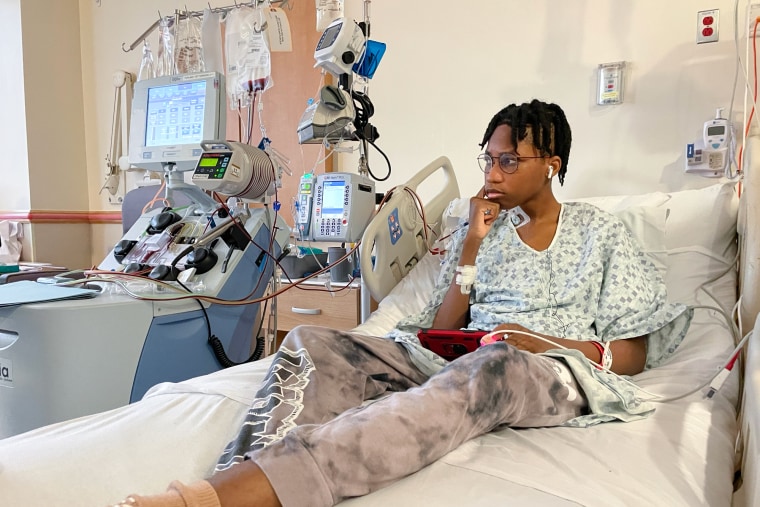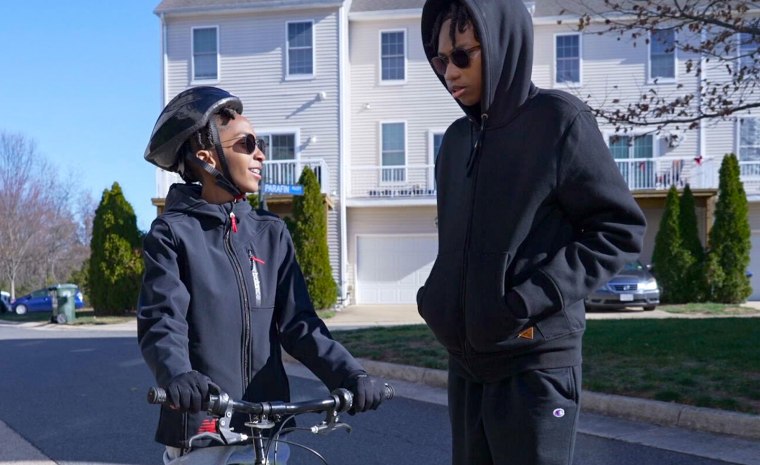WASHINGTON – For Wedam Minyila, hospital rooms have always meant blinding pain. “Like someone stuck a knife in me,” he said.
But for a moment on a recent December morning, 19-year-old Wedam, who has sickle cell disease, allowed himself to believe what his doctors had been telling him for months: This visit could be the first step toward a cure. As one of the first patients in the world to receive commercial treatment for the genetic condition, he was able to imagine a future without excruciating pain.
“I choose to partially believe it,” he said on the day he was admitted to Children’s National Hospital in Washington, D.C., for his stem cell collection — the first major step in the revolutionary process of sickle cell gene therapy. “But that also brings with it skepticism: will it really work?”

It’s the same question sickle cell patients across the country have been asking since the Food and Drug Administration approved two gene therapies that could cure the disease’s symptoms just over a year ago.
Since then, only a few dozen patients across the country have had access to it. Paperwork, a multimillion-dollar price tag and patient concerns about serious side effects mean that only a limited number of hospitals have treated patients so far.
More than 100,000 people in the United States – 9 in 10 of whom are black – have sickle cell disease. The hereditary disease causes red blood cells, usually round, to contort into a crescent or sickle shape. The sickle-shaped cells often build up in blood vessels, resulting in excruciating pain, strokes, organ damage and shortened lives. The new gene therapies, one from Boston-based Vertex Pharmaceuticals and the other from Somerville, Mass.-based Bluebird Bio, offer a potential cure.
That’s why Wedam left his skepticism behind him – and went through months of insurance approvals and medical consultations.
“I know what it can do for me,” he said softly as a team of medical professionals began to swarm by his bedside. “But until it happens, I’m not as excited as everyone else.”
His mother, Sylvia, watched with bated breath from the corner of the room. “This is something completely new,” she said. “And I never thought that we would be one of the pacesetters in this. It feels surreal.”
But the first step of what she describes as her “miracle” happened before her eyes: Nurses gave her son a drug to mobilize stem cells normally trapped in the bone marrow to flow into the bloodstream. A few hours later, Wedam was connected to a so-called apheresis machine, which sucks blood from the body and then spins it at high speed to separate the millions of stem cells before returning the rest of the blood to the body. veins.
Dr. Andrew Campell stepped up to Wedam’s bedside as the first pale orange fluid containing his stem cells began to collect in an IV bag hanging next to him.
“You’re one of the few in the country and even in the world, you know, taking this big step: gene therapy,” said Campbell, director of the hospital’s Comprehensive Sickle Cell Disease Program. “It took a lot of courage, because I know this is still very new in the process.”
Wedam looked unfazed. “I had to,” he said. “There isn’t anything I could really pass up. So I didn’t really have a choice.”
A learning curve for hospitals
In the coming months, Wedam’s cells will be shipped to a lab in Tennessee, where technicians will use a gene-editing tool called CRISPR to modify a gene in the stem cells so that they produce red blood cells that are less likely to sickle and block blood flow. , resulting in pain crises.
Wedam will need intensive chemotherapy to wipe out his existing stem cells and make room in his bone marrow for the gene-edited cells, which a team at Children’s National Hospital will reintroduce into his bloodstream intravenously.
“To be able to provide a therapy that is a cure and will keep him out of the hospital and probably prolong his life, that’s amazing,” said Dr. David Jacobsohn, chief of blood and marrow transplantation at Children’s National. “It’s very, very powerful what we can offer now compared to five or 10 years ago.”

Still, Jacobsohn acknowledged that few patients have started gene therapy treatment. At Children’s National — which led the way after participating in Bluebird Bio’s clinical trials — only 10 people, including Wedam, initiated or completed the process. That’s from a group of about 1,500 patients with sickle cell disease that the team is treating in the Washington area.
“In the beginning, the leaders at the hospital were super enthusiastic. They said, ‘We have dozens and dozens of eligible patients. We need to build more beds!’ And I have a feeling that will happen eventually, but it won’t happen right away,” he said. “It’s been a learning curve for the hospitals, and it’s been a learning curve for the insurance companies.”
Jacobsohn said his team is gearing up to start treatment on one or two patients a month — a pace he called “exciting.”
“Be aware that this is a very risky treatment that requires high-dose chemotherapy with the potential for complications,” he said. “So it’s not something we want to ramp up too quickly.”
Vertex Pharmaceuticals’ month-long treatment Casgevy has a list price of $2.3 million. Bluebird Bio’s Lyfgenia is listed at $3.1 million. Nor are the costs of care for hospital stays or chemotherapy included.
To control the high price tag, insurers have implemented extensive pre-authorization procedures. Both pharmaceutical companies told NBC News that they have not yet seen an “ultimate denial” for their drugs.
The procedure is labor-intensive for the limited number of hospitals authorized to perform it, requiring several days in the hospital for the stem cell collection and, months later, multi-week hospital stays for chemotherapy and the reintroduction of the stem cells, Jacobsohn said. In between, the stem cell processing lab takes several months to genetically alter the cells and perform safety checks before sending them back to the hospital for infusion.
For patients like Wedam, there are also other considerations. The intensive chemotherapy lasts four days and makes patients extremely ill and susceptible to infections. Many develop ulcerative ulcers in their mouth, throat and esophagus that make eating almost impossible. In the longer term, chemotherapy increases the risk of cancer and infertility.
For all these reasons, only one patient has completed the trial at City of Hope Children’s Cancer Center in Los Angeles. Dr. Leo Wang, a pediatric hematologist-oncologist at the center, says he expects that number to rise rapidly in the coming months after early adopters begin to show success.
“We are hopeful that adoption will increase and become more acceptable to people who may be a little more risk-averse,” Wang said. “And we’ve already seen patients come and ask us about it and say, ‘Well, I’d really like to talk to someone who’s already been through this and hear their perspective, and then maybe I’ll be interested in that.’”
“God, you did this for me.”
That’s one of Wedam’s motivations for becoming an early adopter. “If all those people could see me and see that it’s working, they’ll have some hope,” he said. “Even if only a little bit.”
The disease has robbed him of his ability to do much of anything, including getting out of bed. But the idea of a cure makes him dream of one day becoming a filmmaker.
In the short term, his ambitions are much smaller: He would like to attend his college classes in person rather than online.
“Now I can’t really keep up with most of my friends, so I might make new ones,” he said. “I could learn the material better if I was there in person and asked the teacher actual questions. I just think that, as a normal person, doing what a normal person would do, I think that’s what really excites me.
The disease ravaged the Minyila family for almost twenty years. In addition to Wedam, his 14-year-old brother Wekem also has sickle cell disease.

“It took almost everything,” Sylvia Minyila said. “It took away our joy.”
Wedam, she said, was once a happy boy who loved school and dancing. But when his pain crises started around middle school, she said, he changed.
“He became withdrawn. “Anywhere there was bone, he could have pain there,” she said. “Wherever you were in the house you could hear him moaning. And this is something I used to think about regularly: ‘Am I going to lose him?’ Because he was in so much pain.”
Until gene therapy, the only cure for sickle cell disease was a stem cell transplant from a donor. That worked for Wekem after Sylvia discovered she was a match for her youngest son. After some scary complications, the procedure was successful.
But antibodies in Wedam’s bloodstream prevented him from receiving the same healing.
“I was ecstatic. I said, ‘God, you did this for me. But what about my other son?” Sylvia said, tears rolling down her cheeks. “I also wanted that for Wedam.”
She said that when the doctors at Children’s Hospital called her just months later to let her know that Wedam might be a good candidate for the new gene therapy, it felt like a double miracle: an answer to her prayers.
“The only thing I kept asking was, ‘Is it curative?’ Is this something he still needs to take medication for? Will he have pain crises?’ They said, ‘No.’ And I said, ‘We’re in. We’re in.’”
Wedam has seen his younger brother transform since his treatment – even using his new energy to teach himself to ride a bike. The unbearable pain prior to Wekem’s stem cell transplant had made that impossible.
Wekem said he looks forward to his older brother being healed.
“I feel like it changed the life he’s going to live,” Wekem said. “I didn’t really think there would be anything else available to us so he could be treated and healed.”
But Wedam remains skeptical. “Maybe 60%,” he said of his chances of recovery.
But even with the life-threatening complications that can arise, he says, it’s worth a try if there’s any chance of a less painful future.
NBC News will continue to follow Wedam Minyila’s journey as he begins the next phases of his sickle cell treatment.